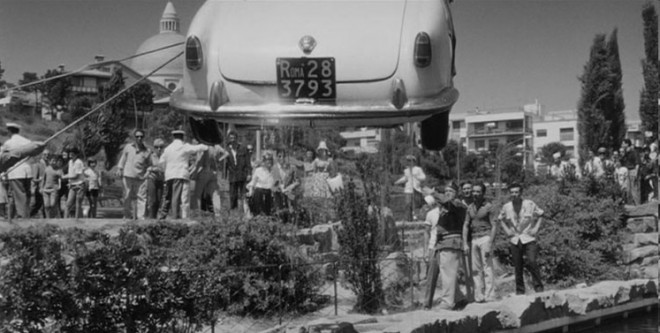Exceptionally fine, Bruno Dumont’s La vie de Jésus is about aimless contemporary youth. The film isn’t entirely original; it borrows a bit from Fellini and heavily—thematically, stylistically—from Bresson. (Its rigor lightly relaxed, it could be called ‘Bresson lite.’) However, the film nicely absorbs its borrowings and, despite some boorish anti-racist preachiness, makes a coherent impression. It’s a far better film than, say, Mathieu Kassovitz’s La haine (1995), whose success may have partly inspired it.
Life of Jesus charts a nasty boy’s thorny path to redemption. In ’90s northern France—the part of the country Dumont himself comes from—a motorbiking gang remain otiose, foul-mouthed, reckless while nominally leaving their teen years behind. Frédéric, the film’s main character, still answers to the child’s name ‘Freddy’; nineteen or twenty, he lives with his widowed mother, a barmaid, and a pet finch, Leo. Unlike Marie, his girlfriend, he doesn’t hold a job and is too shiftless to look for one. When Kadder starts taking an interest in Marie, Freddy goes into jealous overdrive and, helped by his buddies, stomps the Arab boy to death on a country road. Freddy flees the law. At the rock bottom of his humanity, he is now ripe for God’s grace.
Dumont directed from his own script. Although his Life of Jesus lacks the clarity or force of Bresson’s Pickpocket (1959) or Mouchette (1966), I had no trouble taking Freddy’s redemption on faith, especially as I had been referencing Bresson all along. The film’s Bressonian lack of sentimentality is most helpful. For example, Kadder is no moony-eyed charmer; besides being ugly, he is no less obnoxious than Freddy. Kadder is relentless in his romantic pursuit of the “taken” Marie—however sincerely motivated, activity inviting the others’ retribution. Bluntly stated, this boy would rather nurture his feelings of racial hurt than reach out in order to win over the other boys as friends; after they call him a “wog” and a “dirty Arab,” he shouts at them, “Fucking French sons of bitches.” But this mirror-imaging of their adolescent defensiveness introduces the kinship between Kadder and Freddy that speaks to the film’s principal theme. Dumont completes this connection visually. When Marie and Kadder hug in the street, the angry boy, calmed, looks up at a white cloud in the blue sky. At the end of the film, Freddy is lying in a field; what he has done to Kadder finally, fully has settled in. He looks up at clouds in the sky, from behind which the sun emerges. Dumont could not make plainer the two boys’ joint destiny, the debt each owes God for the quiet miracle of grace at last resolving, across the boundary of life, the contentiousness that embroiled them both.
Dumont, alert, has prepared us for this stunning conclusion in other ways as well. Early on, Freddy and his friends, including Michou, visit Michou’s brother, Ciocio, in hospital. Ciocio is dying of AIDS. Showing the sensitivity he generally suppresses, Freddy approaches Ciocio, who has already, undetectably, passed; in an image of crucifixion, the dead man’s eyes “look up” at Freddy, calling forth the live boy’s compassion. Owing to his epilepsy, Freddy himself will be tested at the same hospital; along with their tortured masks (Freddy’s seizures; Ciocio’s pain-screwed face), this commonality of place predicts by Ciocio’s redemption Freddy’s redemption. Indeed, Freddy’s epileptic fits constitute a splendid—if, for us ‘politically correct’ Americans, risky—motif. Besides imaging Freddy’s gross immaturity and patently unredeemed state, they also periodically remind us of his humanity, no matter the wretchedness of his behavior. At film’s end, before the sun’s emergence, Freddy fails in his attempt to flagellate himself into a seizure—a clarification of the complexity of Dumont’s symbolical use of Freddy’s epilepsy. This condition, then, signifies the boy’s well-rehearsed inhumanity. The act, for him, is no longer sustainable.
What an eye Dumont possesses. The film’s opening movement is extraordinary. On his motorcycle, Freddy is in motion; here is an image of openness, possibility. The shot, executed from Freddy’s point of view, shows field and woods rushing back from him as he speeds ahead. Then, with a cut, the shot shifts to an objective point of view; a receding camera shows Freddy advancing towards us. This flip from subjective camera to objective camera Dumont repeats throughout the film; here, at the outset, it establishes the connection between us, representing humanity, and the boy’s potential. Both he and we thus participate in the design of God’s that Dumont means for us to intuit—a point Dumont underscores by the ringing of church bells the moment the boy reaches town. Just before arriving home, the boy spills, bruising himself on the street. How rocky his road to salvation will be. This opening movement of Dumont’s skillfully telescopes the entire film.
Prepare yourself, though, for his take on adolescent sex; rather than lovemaking, it consists of something rather more onanistic. The girl is so passive, the sex seems to exist only for Freddy. Here, too, we are confronted with Freddy’s practiced inhumanity—sex as a form of epileptic fit.
David Douche is excellent as Freddy. (Unfortunate name, though!) I presume that he and the rest of the cast are nonprofessionals. Their work is all of a convincing piece—though here again the effect is not so profound as with Bresson.
Philippe Van Leeuw is the color cinematographer. His landscapes are sometimes softly bleak, sometimes softly ravishing.
Dumont’s film boasts a host of prizes: the Prix Jean Vigo, the International Jury Award at the Sao Paulo International Film Festival, the “Discovery of the Year” European Film Award, the Sutherland Trophy at the London Film Festival, and the FIPRESCI Award at the Chicago International Film Festival.
B(U)Y THE BOOK
MY BOOK, A Short Chronology of World Cinema, IS CURRENTLY AVAILABLE FROM THE SANDS FILMS CINEMA CLUB IN LONDON. USING EITHER OF THE LINKS BELOW, ACCESS THE ADVERTISEMENT FOR THIS BOOK, FROM WHICH YOU CAN ORDER ONE OR MORE COPIES OF IT. THANKS.
